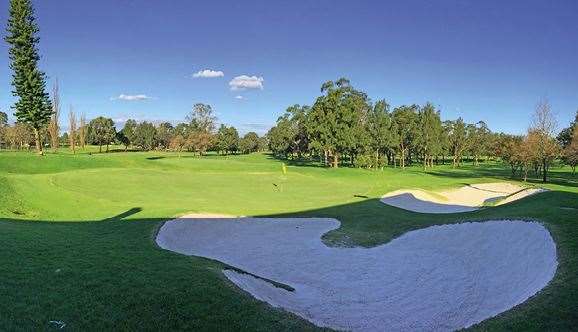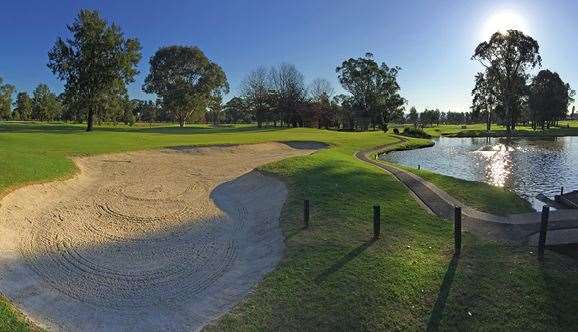The oldest course in our oldest state attracts Australia's leading senior professionals each spring - and avid golfers year-round.
WORDS: STEVE KEIPERT PHOTOGRAPHY: BRENDAN JAMES
Richmond Golf Club is a comfortable half-hour drive from my house and I’ve played the course on bitter winter days, hot summer scorchers and in the more temperate weather of spring and autumn. It truly is a course for all seasons.
And it’s been that way for a long, long time. Richmond Golf Club began life in 1899 with play on the site dating back two years prior to that, making it the oldest club on its original site in New South Wales. These days, this challenging yet highly playable course is receiving its long-due attention as the home of the $100,000 Australian PGA Seniors Championship. Richmond will host the nation’s biggest over-50s tournament for the third time this November with the club locked in to stage at least the 2016 and 2017 events as well.
Former PGA of Australia tournament co-ordinator Darryl Purchase captured the first edition at Richmond before two former Open Championship runners-up, Victorian Mike Harwood and New Zealand’s Simon Owen, went an extra hole last year with the Kiwi taking the trophy.
Both editions were heartily received by galleries, sponsors and players alike. But pros will be pros, and some players gave advice about how to improve the course. The club acted on their recommendations at the 12th, a par-3 with a huge teeing ground that can see the hole play as long as 167 metres or as short as 117 to what was a tiny green with bunkers left and right plus another menacing pot right in front. The front bunker was replaced by a small mound to disperse running shots but not completely prevent their path towards the flag, while the green is now much wider in the back section. The hole is markedly better.
Playing the par-70 course, it’s easy to see why it has quickly become a popular venue for both the players and the PGA of Australia. The layout is flat and compact but uses its attributes cleverly, mixing short with long, straight with doglegging, tree-lined with spacious. For recreational players through to serious club golfers, playing the course is an excursion with more variety than is apparent at first glance as the layout possesses characteristics that can only be appreciated after several rounds. Richmond is also home to the best three consecutive holes outside a Top 100-ranked course you’re likely to find this side of the Sandbelt (more on those later).
A few years ago, the club re-routed the layout slightly by switching the two closing holes on each nine. These alterations had a positive effect on the entire layout. Firstly, it removed a bottleneck early in the round. What is now the mid-length par-3 8th hole was formerly the 2nd hole, which placed back-to-back short holes at the start – never a helpful factor when it comes to managing pace of play. Secondly, the gambling short par-4 that is now the 18th used to be the 9th and while the essence of the hole didn’t change, its risk/reward qualities are far better suited to close the round when everything is on the line. Finally, the overall flow of the course is better under the current configuration, with a better separation of the longer and shorter par-4s.
The Richmond layout begins with a straight par-5 of 507 metres between twin treelines that point towards a gently angled green favouring a right-to-left approach shot. The 2nd might be the easiest hole on paper but that doesn’t make it simple. The 144-metre par-3 is lined by water left and long and the green features three subtly distinct segments. There are numerous ways to tackle the 3rd hole, a 335-metre par-4 turning sharply left around a lake that dominates the hole. Right-to-left players have the advantage and some big-hitting rogues even attempt a heroic drive across the water towards the green. The best play is a long iron or fairway wood to the right side of the fairway and a second shot fired over the hazard down the length of the narrow green. It’s one of those holes where scorecards can easily self-destruct in a heartbeat so caution is advisable.
Long par-4s at the next two holes illustrate the course’s variety. The 4th doglegs right around a lateral hazard that runs parallel to an out-of-bounds fence towards a green with no hazards around it – no bunkers (other than distant ones adjoining the 6th green), no swales and only the lateral hazard in the distance. The difficulty is in the tee shot so the reward is a more manageable approach. The 5th offers the reverse, plenty of room from the tee before a raised, sloping green with bunkers right and left. The approach shot and any subsequent greenside shots are tough examinations, while the camber of the green can make fools out of even the best putters.
Later, the front nine closes with a meaty two-shotter that was the 18th hole before the reconfiguration. The 375-metre par-4 is another straight hole played between opposing flanks of tall trees to a raised green with surrounding slopes that repel rather than gather approach shots. Any par made here is to be treasured.
There’s more versatility starting the back nine. The par-3 10th and 12th holes feature teeing grounds that change the nature of both holes in an instant. The championship tee at No.10 pushes the hole to 175 metres, a difficult shot to a small green, but playing from the everyday tee poses a different challenge. Set nearly 45 degrees to the left, the 144-metre tee brings the modest water carry more into view and creates an angle that appears to open up the green but in doing so also opens up the route to the bunkers and swales where you don’t want a ball to finish. Up ahead, the revitalised 12th still features a tee that’s almost long enough to house another par-3, with teeing distances varying by up to 50 metres. The green complex is now larger and fairer, but whichever club you’re wielding the swing has to be a good one.
The stretch of holes from 13 to 15 is Richmond’s ‘Amen Corner’ a par-4, par-4, par-3 combo that is the highlight of the round. The 386-metre 13th bends ever so slightly right before a long second to a green that’s far larger than is apparent from the fairway with a large, bushy maple tree guarding the right side. It’s also a hole where a 60-foot putt or longer is no one’s idea of fun. The 14th is a centrepiece hole in every way. The fairway turns left around one lake then twists back to the right around a second pond. Finding the exposed green in regulation figures requires two fine shots shaped in opposite directions and the heart to execute both with conviction. Otherwise, it’s 384 metres of sheer calamity.
The short 15th can be more of the same. It plays across the side of the second lake traversed in completing the previous hole. The wide, shallow green can be accessed on the left side without a water carry but any shot heading for the centre of the putting surface or the more dangerous right third must take on the lake. It’s a trio of holes where good golfers revel and bad scores are only too common.
Many courses like to test golfers’ resolves over the closing stretch but the Richmond layout taxes players enough through the first 15 holes to ease off near the end and offer a chance to repair any damage sustained along the way. The 16th is the course’s most ‘get-able’ par-5, playing slightly downhill to a fairway that doglegs right and rises to a huge, deep green that accepts running shots. The 17th is a drive-and-pitch par-4 to a thin green with sand all around it, placing a premium on accuracy from the tee. The closer is the aforementioned 248-metre par-4 that can be driven by many handicap golfers to set up an eagle putt but out-of-bounds lines the entire left side of the hole and three bunkers protect the left, right and rear parts of the green. Birdies definitely beckon here but for many players the temptation might instead be the simple path to a stress-free par to end the round.
Eagle putts, birdie chances, watery graves and scorecard blow-ups. For a predominantly level course, playing 18 holes at Richmond can be akin to riding a roller-coaster.
Fact File
THE COURSE
LOCATION: Bourke St, Richmond. The course is a 60-minute drive from the Sydney CBD via the M2 and M7 toll roads then either Old Windsor Rd or Richmond Rd. Alternatively, East Richmond train station is right next to the clubhouse.
CONTACT: (02) 4578 1739.
WEBSITE: www.richmondgolfclub.com.au
DESIGNER: Club members (1897).
SLOPE RATINGS: Men: 127/124/122; women: 129/126/117.
PLAYING SURFACES: Bentgrass (greens), kikuyu (tees, fairways and rough).
COURSE SUPERINTENDENT: Mark Williams.
PGA PROFESSIONAL: Mark Eisenhuth.
GREEN FEES: $25 weekdays; $35 weekends.
THE CLUB
MEMBERSHIPS: Richmond offers 11 different membership categories. Full membership is $880 annually, with seniors paying $705 a year and juniors $105. Five- and six-day memberships are also available.
RECIPROCAL CLUBS: Armidale, Barham, Bathurst, Bermagui, Dubbo, Everglades, Forbes, Grafton, Muree, Taree, Wollongong (NSW); Cairns, Karana Downs, Rosewood, Gold Coast CC (Qld); Barossa Valley (SA); Gungahlin Lakes (ACT).
CORPORATE GOLF: The club has six primary corporate golf packages, which can include either nine or 18 holes of golf, a meal, a lesson clinic conducted by the club’s PGA pro and more. Packages can be tailored to suit.
FUNCTIONS: The clubhouse is a popular venue for corporate functions, parties, wedding receptions and casual dining. In 2013, the golf club amalgamated with the Richmond Club, a venue just a kilometre away that is the Hawkesbury region’s premier registered club, offering dining, function and entertainment facilities.
Related Articles

Review: Omaha Beach Golf Club

Course Review: Cape Kidnappers











_15th_hole.jpg&h=115&w=225&c=1&s=1)




